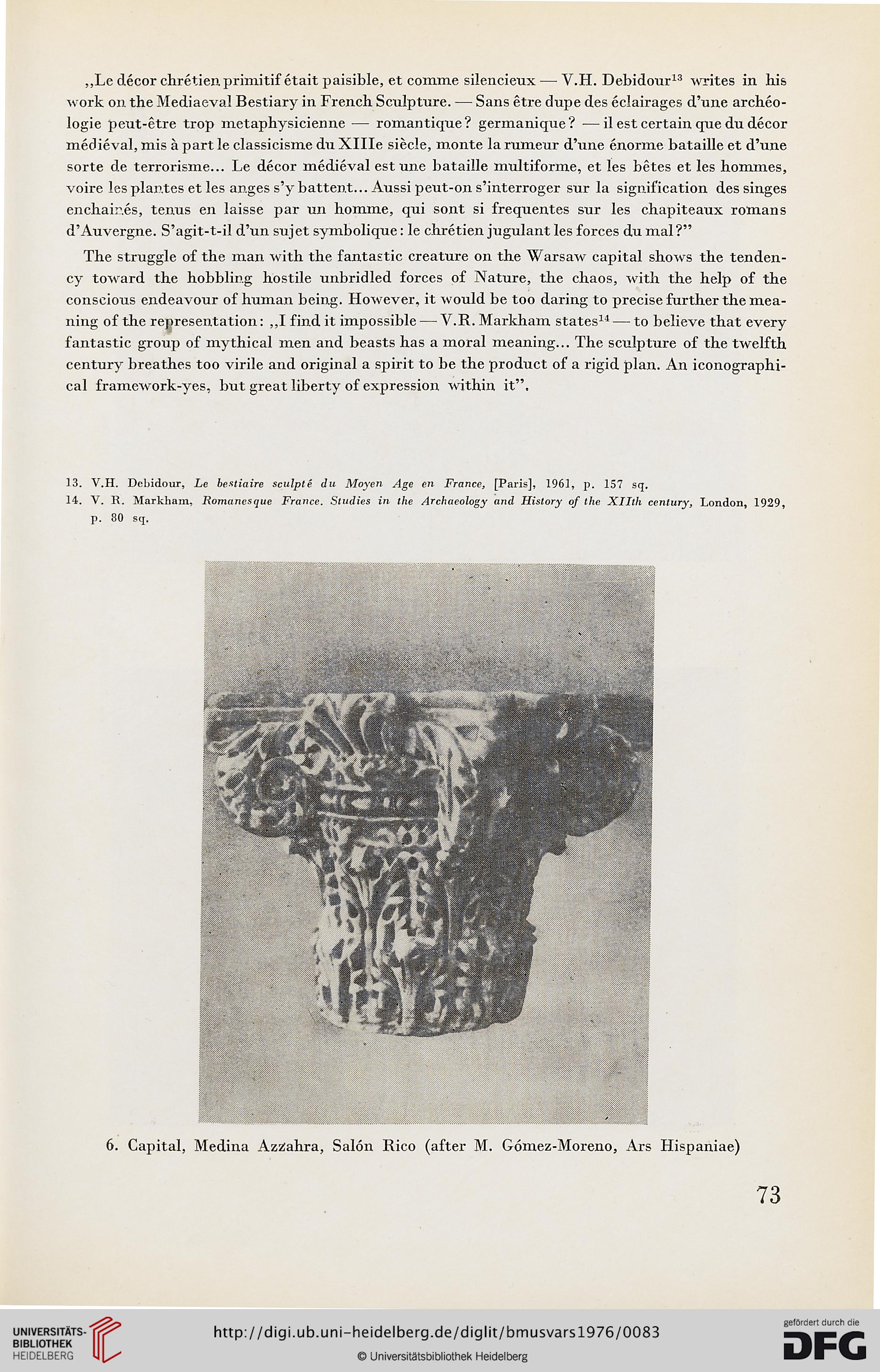„Le decorchretieiiprimitif etait paisible, et comme silencieux— V.H. Debidour13 writes in his
work on the Mediaeval Bestiary in French Sculpture. — Sans etre dupe des eclairages d'une archeo-
logie peut-etre trop metaphysicienne — romantiąue? germaniąue? —il est certain que du decor
medieval, mis a part le classicisme du XIIIe siecle, monte la rumeur d'une enorme bataille et d'une
sorte de terrorisme... Le decor medieval est une bataille multiforme, et les betes et les hommes,
voire les plantcs et les anges s'y batten.t... Aussi peut-on s'interroger sur la signification des singes
enchair.es, tenus en laisse par un homme, qui sont si frequentes sur les chapiteaux romans
d'Auvergne. S'agit-t-il d'un sujet symboliąue: le chretien jugulant les forces du mai?"
The strugglc of the man with the fantastic creature on the Warsaw capital shows the tenden-
cy toward the hobbling hostile unbridled forces of Naturę, the chaos, with the help of the
conscious endeavour of łmman being. However, it would be too daring to precise furtherthe mea-
ning of the representation: ,,I find it impossible — V.R. Markham states14 — to believe that every
fantastic group of mythical men and beasts has a morał meaning... The sculpture of the twelfth
century breathes too virile and original a spirit to be the product of a rigid plan. An iconographi-
cal framework-yes, but great liberty of expression within it".
13. V.H. Debidour, Le hestiairc sculpte du Moyen Age en France, [Paris], 1961, p. 157 sq.
14. V. R. Markham, Romanesquc France. Sludies in the Archacology and Hislory of the XIIth century, London, 1929,
p. 80 sq.
6. Capital, Medina Azżahra, Salon Rico (after M. Gómez-Moreno, Ars Hispaniae)
73
work on the Mediaeval Bestiary in French Sculpture. — Sans etre dupe des eclairages d'une archeo-
logie peut-etre trop metaphysicienne — romantiąue? germaniąue? —il est certain que du decor
medieval, mis a part le classicisme du XIIIe siecle, monte la rumeur d'une enorme bataille et d'une
sorte de terrorisme... Le decor medieval est une bataille multiforme, et les betes et les hommes,
voire les plantcs et les anges s'y batten.t... Aussi peut-on s'interroger sur la signification des singes
enchair.es, tenus en laisse par un homme, qui sont si frequentes sur les chapiteaux romans
d'Auvergne. S'agit-t-il d'un sujet symboliąue: le chretien jugulant les forces du mai?"
The strugglc of the man with the fantastic creature on the Warsaw capital shows the tenden-
cy toward the hobbling hostile unbridled forces of Naturę, the chaos, with the help of the
conscious endeavour of łmman being. However, it would be too daring to precise furtherthe mea-
ning of the representation: ,,I find it impossible — V.R. Markham states14 — to believe that every
fantastic group of mythical men and beasts has a morał meaning... The sculpture of the twelfth
century breathes too virile and original a spirit to be the product of a rigid plan. An iconographi-
cal framework-yes, but great liberty of expression within it".
13. V.H. Debidour, Le hestiairc sculpte du Moyen Age en France, [Paris], 1961, p. 157 sq.
14. V. R. Markham, Romanesquc France. Sludies in the Archacology and Hislory of the XIIth century, London, 1929,
p. 80 sq.
6. Capital, Medina Azżahra, Salon Rico (after M. Gómez-Moreno, Ars Hispaniae)
73




